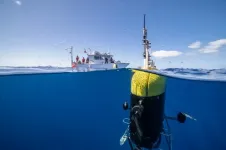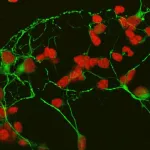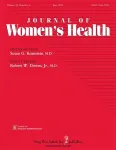(Press-News.org) 'God forbid we need this, but we'll be ready'
Medication would be taken early in the disease, so you don't get as sick
Future drug could also treat common cold
CHICAGO --- Scientists are already preparing for a possible next coronavirus pandemic to strike, keeping with the seven-year pattern since 2004.
In future-looking research, Northwestern University Feinberg School of Medicine scientists have identified a novel target for a drug to treat SARS-CoV-2 that also could impact a new emerging coronavirus.
"God forbid we need this, but we will be ready," said Karla Satchell, professor of microbiology-immunology at Feinberg, who leads an international team of scientists to analyze the important structures of the virus. The Northwestern team previously mapped the structure of a virus protein called nsp16, which is present in all coronaviruses. This new study provides critical information that could aid drug development against future coronaviruses as well as SARS-CoV-2.
"There is great need for new approaches to drug discovery to combat the SARS-CoV-2/COVID-19 pandemic and infections from future coronaviruses," Satchell said.
"The idea is this future drug would work early in the infection," Satchell said. "If somebody around you gets the coronavirus, you would run to the drugstore to get your medication and take it for three or four days. If you were sick, you wouldn't get as sick."
The paper was published in Science Signaling.
Satchell's team has mapped or 'solved' three new protein structures in three-dimensional views and discovered a secret identifier in the machinery that helps the virus hide from the immune system.
They discovered a coronavirus-specific pocket in the protein, nsp16, that binds the virus-genomic fragment held in place by a metal ion. The fragment is used by the coronavirus as the template for all the viral building blocks.
For this reason, Satchell said, there is potential to make a drug to fit this unique pocket that would block function of this protein from the coronavirus. It would not block the function of a similar protein from human cells that lacks the pocket. Thus, such a drug would only target the invader protein.
Nsp16 is considered one of the key viral proteins that could be inhibited by drugs to stop the virus shortly after a person gets exposed. The goal is to stop the virus early before people get too sick. Since little research was done on nsp16, Satchell's team has worked to generate key information about this protein and is collaborating with chemists who will use the information to design drugs against the protein.
While some of the coronavirus proteins vary a lot, nsp16 is nearly the same across most of them. The unique pocket discovered by Satchell's group is present in all the different coronavirus members. This means that drugs designed to fit this pocket should work against all coronaviruses, including a virus that emerges in the future. And it should work against the common cold that is caused by a coronavirus.
Satchell envisions any drug developed from her team's discovery of the coronavirus pocket would be part of a treatment cocktail taken by patients early in the course of the disease. That could include drugs similar to Remdesivir, a drug that prevents the virus from producing the template for the building blocks that is necessary for it to replicate itself.
The team behind the discovery
The Northwestern team in the Center for Structural Genomics of Infectious Diseases (CSGID) expressed, purified and crystallized this protein. The idea of the project came from first study author George Minasov, research associate professor of microbiology-immunology at Feinberg. He worked with Feinberg research associate professor Ludmilla Shuvalova to crystallize the protein and also with post-doctoral fellow Monica Rosas-Lemus, who developed an assay to test the function of the protein based on information from the structure.
The team collaborated with Purdue University investigator Andrew Mesecar, who helped with biochemistry assays. Data on the structure was collected by the Life Sciences Collaborative Access Team at the Advanced Photon Source of Argonne National Laboratories by Joseph Brunzelle. Minasov solved the structure from the collected data. This project is one of many carried out by the CSGID to use structural biology to understand the biology of the virus responsible for the COVID-19 pandemic.
Overall, the center has made significant contributions to the development of vaccines, drugs and diagnostics. The international team has solved more than 70 different viral structures to reveal viral protein structure, interactions with possible drugs and interactions with antibodies. This work is made freely available to the global community to use to accelerate efforts to design new treatments against coronavirus to combat COVID-19 and future pandemics.
INFORMATION:
The CSGID is supported by a contract from the National Institute of Allergy and Infectious Diseases (NIAID), part of the National Institutes of Health, in part to serve as a response site to conduct structure biology research in the event of an unexpected infectious disease outbreak. NIAID has been working closely with the Center since early January to coordinate center activities with other research supported by NIAID to enable drug discovery.
This study was funded by contract HHSN272201700060C from NIAID.
An innovative underwater robot known as Mesobot is providing researchers with deeper insight into the vast mid-ocean region known as the "twilight zone." Capable of tracking and recording high-resolution images of slow-moving and fragile zooplankton, gelatinous animals, and particles, Mesobot greatly expands scientists' ability to observe creatures in their mesopelagic habitat with minimal disturbance. This advance in engineering will enable greater understanding of the role these creatures play in transporting carbon dioxide from the atmosphere to the deep sea, as well as how commercial exploitation of twilight ...
CORVALLIS, Ore. - Human-caused wildfire ignitions in Central Oregon are expected to remain steady over the next four decades and lightning-caused ignitions are expected to decline, but the average size of a blaze from either cause is expected to rise, Oregon State University modeling suggests.
Scientists including Meg Krawchuk of the OSU College of Forestry and former OSU research associate Ana Barros, now of the Washington Department of Natural Resources, say the findings can help local decision-makers understand how a changing climate might affect natural and human-caused fire regimes differently and inform ...
Researchers at the National Eye Institute (NEI) have determined how certain short protein fragments, called peptides, can protect neuronal cells found in the light-sensing retina layer at the back of the eye. The peptides might someday be used to treat degenerative retinal diseases, such as age-related macular degeneration (AMD). The study published today in the Journal of Neurochemistry. NEI is part of the National Institutes of Health.
A team led by Patricia Becerra, Ph.D., chief of the NEI Section on Protein Structure and Function, had previously derived these peptides from a protein called pigment epithelium-derived ...
A study of young immigrant mothers who are survivors of sex trafficking found that the trauma affected how they parented: it made them overprotective parents in a world perceived to be unsafe, it fueled emotional withdrawal when struggling with stress and mental health symptoms, and was a barrier to building confidence as mothers. Yet, they coped with such challenges finding meaning in the birth of their child and through social support and faith.
Results of the community-based participatory research study by researchers at Columbia University ...
An alternate-day intermittent fasting schedule offered less fat-reducing benefits than a matched "traditional" diet that restricts daily energy intake, according to a new, 3-week randomized trial involving 36 participants. The study, which is one of the first to tease apart the effects of fasting and daily energy restriction in lean individuals, indicates that alternate-day fasting may offer no fasting-specific health or metabolic benefits over a standard daily diet. However, the authors caution that longer studies with larger groups are needed. Intermittent fasting, which involves cycling through voluntary fasting and non-fasting periods, has become one of the most popular approaches to losing weight. There ...
We've seen robots take to the air, dive beneath the waves and perform all sorts of maneuvers on land. Now, researchers at UC Santa Barbara and Georgia Institute of Technology are exploring a new frontier: the ground beneath our feet. Taking their cues from plants and animals that have evolved to navigate subterranean spaces, they've developed a fast, controllable soft robot that can burrow through sand. The technology not only enables new applications for fast, precise and minimally invasive movement underground, but also lays mechanical foundations for new types of robots.
"The biggest challenges with moving through the ground ...
In a study of more than 10,600 adult patients hospitalized with COVID-19, women had significantly lower odds than men of in-hospital mortality. They also had fewer admissions to the intensive care unit and less need for mechanical ventilation. Women also had significantly lower odds of major adverse events, including acute cardiac injury, acute kidney injury, and venous thromboembolism, according to an article in the peer-reviewed Journal of Women's Health. Click here to read the article now.
"This comprehensive analysis is the largest study to date that directly assesses the impact of sex on COVID-19 outcomes," ...
Boston - New study results indicate that different comorbid conditions affecting individuals diagnosed with COVID-19 may impact how long they continue to receive positive SARS-CoV-2 polymerase chain reaction (PCR) test results. Individuals diagnosed with COVID-19 who are aged 60+, have three or more chronic medical conditions, particularly diabetes, obesity, rheumatologic disease, or an organ transplant, have positive PCR tests for longer periods of time compared to younger individuals without these comorbidities. However, the data showed no significant difference in the duration of positive PCR tests results by the degree of immunocompromise or for individuals receiving chemotherapy or steroids ...
EAST LANSING, Mich. - The original Star Trek television series took place in a future when space is the final frontier, but humanity hasn't reached that point quite yet.
As researchers like Michigan State University entomologists Sarah Smith and Anthony Cognato are reminding us, there's still plenty to discover right here on Earth.
Working in Central and South America, the duo discovered more than three dozen species of ambrosia beetles -- beetles that eat ambrosia fungus -- previously unknown to science. Smith and Cognato described these new species on June 16 in the journal ZooKeys.
The Spartans also selected ...
Researchers from Skoltech and their colleagues from the UK have managed to create a stable giant vortex in interacting polariton condensates, addressing a known challenge in quantized fluid dynamics. The findings open possibilities in creating uniquely structured coherent light sources and exploring many-body physics under unique extreme conditions. The paper was published in the journal Nature Communications.
In fluid dynamics, a vortex is a region where a fluid revolves around a point (2D) or a line (3D); you've clearly seen one in your sink ...



